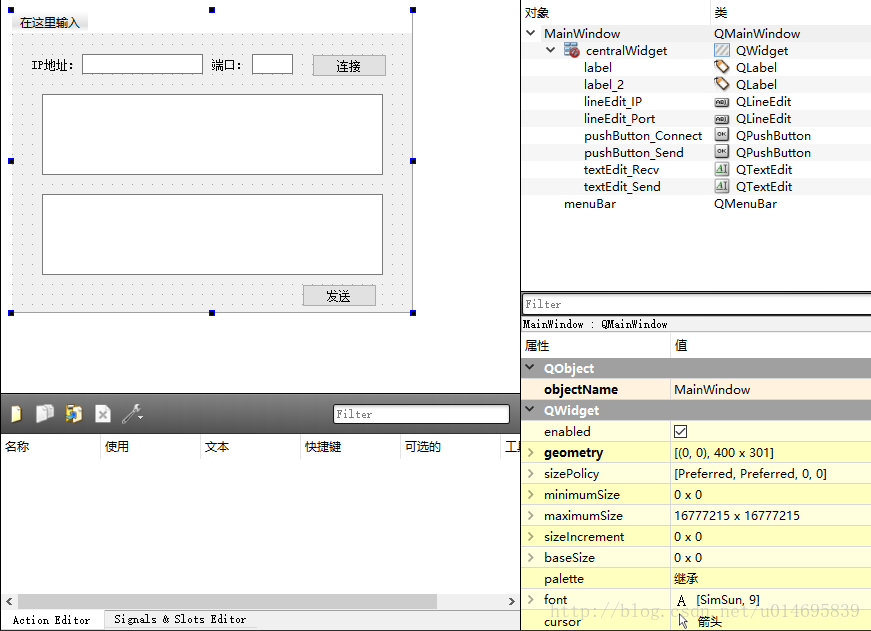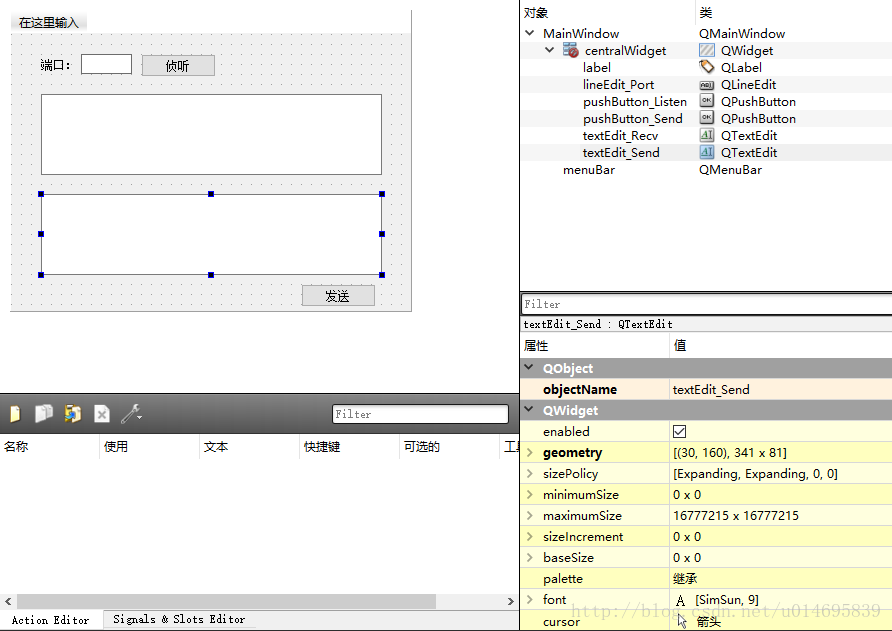QT5如何实现简单的TCP通信
这篇文章主要介绍“QT5如何实现简单的TCP通信”,在日常操作中,相信很多人在QT5如何实现简单的TCP通信问题上存在疑惑,小编查阅了各式资料,整理出简单好用的操作方法,希望对大家解答”QT5如何实现简单的TCP通信”的疑惑有所帮助!接下来,请跟着小编一起来学习吧!
使用QT的网络套接字需要.pro文件中加入一句:
QT += network一、客户端
客户端的代码比服务器稍简单,总的来说,使用QT中的QTcpSocket类与服务器进行通信只需要以下5步:
(1)创建QTcpSocket套接字对象
socket = new QTcpSocket();(2)使用这个对象连接服务器
socket->connectToHost(IP, port);(3)使用write函数向服务器发送数据
socket->write(data);(4)当socket接收缓冲区有新数据到来时,会发出readRead()信号,因此为该信号添加槽函数以读取数据
QObject::connect(socket, &QTcpSocket::readyRead, this, &MainWindow::socket_Read_Data); void MainWindow::socket_Read_Data(){ QByteArray buffer; //读取缓冲区数据 buffer = socket->readAll();}(5)断开与服务器的连接(关于close()和disconnectFromHost()的区别,可以按F1看帮助)
socket->disconnectFromHost();以下是客户端的例程
首先是mainwindow.h文件:
//mainwindow.h#ifndef MAINWINDOW_H#define MAINWINDOW_H #include <QMainWindow>#include <QTcpSocket> namespace Ui {class MainWindow;} class MainWindow : public QMainWindow{ Q_OBJECT public: explicit MainWindow(QWidget *parent = 0); ~MainWindow(); private slots: void on_pushButton_Connect_clicked(); void on_pushButton_Send_clicked(); void socket_Read_Data(); void socket_Disconnected(); private: Ui::MainWindow *ui; QTcpSocket *socket;}; #endif // MAINWINDOW_H然后是mainwindow.cpp文件:
//mainwindow.cpp#include "mainwindow.h"#include "ui_mainwindow.h" MainWindow::MainWindow(QWidget *parent) : QMainWindow(parent), ui(new Ui::MainWindow){ ui->setupUi(this); socket = new QTcpSocket(); //连接信号槽 QObject::connect(socket, &QTcpSocket::readyRead, this, &MainWindow::socket_Read_Data); QObject::connect(socket, &QTcpSocket::disconnected, this, &MainWindow::socket_Disconnected); ui->pushButton_Send->setEnabled(false); ui->lineEdit_IP->setText("127.0.0.1"); ui->lineEdit_Port->setText("8765"); } MainWindow::~MainWindow(){ delete this->socket; delete ui;} void MainWindow::on_pushButton_Connect_clicked(){ if(ui->pushButton_Connect->text() == tr("连接")) { QString IP; int port; //获取IP地址 IP = ui->lineEdit_IP->text(); //获取端口号 port = ui->lineEdit_Port->text().toInt(); //取消已有的连接 socket->abort(); //连接服务器 socket->connectToHost(IP, port); //等待连接成功 if(!socket->waitForConnected(30000)) { qDebug() << "Connection failed!"; return; } qDebug() << "Connect successfully!"; //发送按键使能 ui->pushButton_Send->setEnabled(true); //修改按键文字 ui->pushButton_Connect->setText("断开连接"); } else { //断开连接 socket->disconnectFromHost(); //修改按键文字 ui->pushButton_Connect->setText("连接"); ui->pushButton_Send->setEnabled(false); }} void MainWindow::on_pushButton_Send_clicked(){ qDebug() << "Send: " << ui->textEdit_Send->toPlainText(); //获取文本框内容并以ASCII码形式发送 socket->write(ui->textEdit_Send->toPlainText().toLatin1()); socket->flush();} void MainWindow::socket_Read_Data(){ QByteArray buffer; //读取缓冲区数据 buffer = socket->readAll(); if(!buffer.isEmpty()) { QString str = ui->textEdit_Recv->toPlainText(); str+=tr(buffer); //刷新显示 ui->textEdit_Recv->setText(str); }} void MainWindow::socket_Disconnected(){ //发送按键失能 ui->pushButton_Send->setEnabled(false); //修改按键文字 ui->pushButton_Connect->setText("连接"); qDebug() << "Disconnected!";}最后是ui的设计:

二、服务器
服务器除了使用到了QTcpSocket类,还需要用到QTcpSever类。即便如此,也只是比客户端复杂一点点,用到了6个步骤:
(1)创建QTcpSever对象
server = new QTcpServer();(2)侦听一个端口,使得客户端可以使用这个端口访问服务器
server->listen(QHostAddress::Any, port);(3)当服务器被客户端访问时,会发出newConnection()信号,因此为该信号添加槽函数,并用一个QTcpSocket对象接受客户端访问
connect(server,&QTcpServer::newConnection,this,&MainWindow::server_New_Connect); void MainWindow::server_New_Connect(){ //获取客户端连接 socket = server->nextPendingConnection();}(4)使用socket的write函数向客户端发送数据
socket->write(data);(5)当socket接收缓冲区有新数据到来时,会发出readRead()信号,因此为该信号添加槽函数以读取数据
QObject::connect(socket, &QTcpSocket::readyRead, this, &MainWindow::socket_Read_Data); void MainWindow::socket_Read_Data(){ QByteArray buffer; //读取缓冲区数据 buffer = socket->readAll();}(6)取消侦听
server->close();以下是服务器的例程
首先是mainwindow.h文件:
//mainwindow.h#ifndef MAINWINDOW_H#define MAINWINDOW_H #include <QMainWindow>#include <QTcpServer>#include <QTcpSocket> namespace Ui {class MainWindow;} class MainWindow : public QMainWindow{ Q_OBJECT public: explicit MainWindow(QWidget *parent = 0); ~MainWindow(); private slots: void on_pushButton_Listen_clicked(); void on_pushButton_Send_clicked(); void server_New_Connect(); void socket_Read_Data(); void socket_Disconnected(); private: Ui::MainWindow *ui; QTcpServer* server; QTcpSocket* socket;}; #endif // MAINWINDOW_H然后是mainwindow.cpp文件:
#include "mainwindow.h"#include "ui_mainwindow.h" MainWindow::MainWindow(QWidget *parent) : QMainWindow(parent), ui(new Ui::MainWindow){ ui->setupUi(this); ui->lineEdit_Port->setText("8765"); ui->pushButton_Send->setEnabled(false); server = new QTcpServer(); //连接信号槽 connect(server,&QTcpServer::newConnection,this,&MainWindow::server_New_Connect);} MainWindow::~MainWindow(){ server->close(); server->deleteLater(); delete ui;} void MainWindow::on_pushButton_Listen_clicked(){ if(ui->pushButton_Listen->text() == tr("侦听")) { //从输入框获取端口号 int port = ui->lineEdit_Port->text().toInt(); //监听指定的端口 if(!server->listen(QHostAddress::Any, port)) { //若出错,则输出错误信息 qDebug()<<server->errorString(); return; } //修改按键文字 ui->pushButton_Listen->setText("取消侦听"); qDebug()<< "Listen succeessfully!"; } else { socket->abort(); //取消侦听 server->close(); //修改按键文字 ui->pushButton_Listen->setText("侦听"); //发送按键失能 ui->pushButton_Send->setEnabled(false); } } void MainWindow::on_pushButton_Send_clicked(){ qDebug() << "Send: " << ui->textEdit_Send->toPlainText(); //获取文本框内容并以ASCII码形式发送 socket->write(ui->textEdit_Send->toPlainText().toLatin1()); socket->flush();} void MainWindow::server_New_Connect(){ //获取客户端连接 socket = server->nextPendingConnection(); //连接QTcpSocket的信号槽,以读取新数据 QObject::connect(socket, &QTcpSocket::readyRead, this, &MainWindow::socket_Read_Data); QObject::connect(socket, &QTcpSocket::disconnected, this, &MainWindow::socket_Disconnected); //发送按键使能 ui->pushButton_Send->setEnabled(true); qDebug() << "A Client connect!";} void MainWindow::socket_Read_Data(){ QByteArray buffer; //读取缓冲区数据 buffer = socket->readAll(); if(!buffer.isEmpty()) { QString str = ui->textEdit_Recv->toPlainText(); str+=tr(buffer); //刷新显示 ui->textEdit_Recv->setText(str); }} void MainWindow::socket_Disconnected(){ //发送按键失能 ui->pushButton_Send->setEnabled(false); qDebug() << "Disconnected!";}最后是ui的设计:

三、运行结果

到此,关于“QT5如何实现简单的TCP通信”的学习就结束了,希望能够解决大家的疑惑。理论与实践的搭配能更好的帮助大家学习,快去试试吧!若想继续学习更多相关知识,请继续关注编程网网站,小编会继续努力为大家带来更多实用的文章!
免责声明:
① 本站未注明“稿件来源”的信息均来自网络整理。其文字、图片和音视频稿件的所属权归原作者所有。本站收集整理出于非商业性的教育和科研之目的,并不意味着本站赞同其观点或证实其内容的真实性。仅作为临时的测试数据,供内部测试之用。本站并未授权任何人以任何方式主动获取本站任何信息。
② 本站未注明“稿件来源”的临时测试数据将在测试完成后最终做删除处理。有问题或投稿请发送至: 邮箱/279061341@qq.com QQ/279061341














